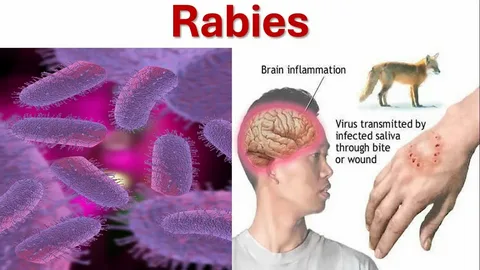Rabies may sound like an old-world disease, something that rarely happens today, but the truth is that it remains one of the deadliest viruses on earth. It kills thousands of animals and people every year, often because of one simple mistake—neglecting to vaccinate pets. Many pet owners assume their animal companions are safe indoors or believe rabies is no longer a concern in modern communities. But the virus still exists in wildlife, waiting for a chance encounter to spread. The key to keeping your pets and loved ones safe lies in one preventive step: regular rabies vaccination.
How Rabies Affects Animals and Humans
Rabies attacks the central nervous system of mammals, slowly shutting down brain function until the body can no longer survive. Once symptoms appear, the disease is nearly 100% fatal. There’s no cure—only prevention. The virus spreads through saliva, most commonly from the bite of an infected animal. Wild species such as bats, raccoons, foxes, and skunks can carry the disease without showing immediate signs, making every bite or scratch a potential risk.
For humans, an unvaccinated pet that comes into contact with a rabid animal poses a serious danger. Even minor contact can lead to panic, emergency vaccinations, and painful treatment regimens. But when your pets are protected, you’re effectively building a wall that keeps rabies from crossing into your home.
Vaccination as a Form of Protection and Compassion
Vaccinating your pets against rabies isn’t just an obligation—it’s an act of love. It ensures their safety and shows that you take their well-being seriously. When you vaccinate your dog or cat, you’re providing them with the power to resist one of the deadliest viruses known to science. You’re also protecting other animals and people who come into contact with your pet. Rabies vaccination is the ultimate form of preventive care because it shields your pet from something that cannot be cured once it takes hold.
The Overlooked Risk of Indoor Pets
A common misconception among pet owners is that indoor animals don’t need rabies shots. While it might seem logical to assume that cats or small dogs living inside are safe, reality tells a different story. Bats can fly through open windows or attics, and infected animals sometimes find their way into garages or backyards. Even short outdoor walks or quick escapes through open doors can expose pets to wild carriers. Vaccinating ensures that even these rare, unpredictable moments don’t turn into disasters.
Community Protection Through Responsibility
When pet owners keep up with rabies vaccinations, they do more than protect their own animals—they contribute to public safety. A single unvaccinated animal can restart the spread of rabies in an entire neighborhood. Communities that maintain high vaccination rates see lower risks of outbreaks, fewer emergency cases, and better control of animal populations. This shared sense of responsibility is the foundation of safe living among pets, people, and wildlife.
Legal Requirements and Peace of Mind
In many areas, rabies vaccination is legally required for all pets. These laws aren’t arbitrary; they exist to prevent outbreaks and unnecessary deaths. Having an up-to-date rabies certificate saves you stress if your pet ever bites someone or gets lost. An unvaccinated pet can be taken away or placed under strict quarantine, while a vaccinated one can be cleared with minimal concern. Keeping records current not only follows the law but also protects your pet’s freedom and your own peace of mind.
The Economic Side of Prevention
Prevention is always more affordable than treatment. Rabies shots are inexpensive compared to the cost of emergency medical care, quarantine fees, or legal fines associated with unvaccinated pets. Treating an exposed human can also cost thousands of dollars. By simply scheduling regular rabies vaccines, you avoid financial burdens and emotional strain. It’s one of the smartest investments any pet owner can make.
How Veterinarians Support Rabies Awareness
Veterinarians are key figures in keeping rabies under control. They help educate communities, track vaccination rates, and ensure every pet receives appropriate boosters. Clinics often host vaccination drives to make the process affordable and accessible. Through continued awareness campaigns, professionals reinforce the message that rabies prevention is a shared duty among all pet owners.
Dispelling Myths About Vaccination Safety
Some people hesitate to vaccinate due to misinformation about side effects. In reality, rabies vaccines are among the safest veterinary procedures. Mild symptoms such as slight fatigue or soreness at the injection site are short-lived. The protection, however, lasts for years and can mean the difference between life and death. Trusting scientific evidence and veterinary advice ensures your pet’s health remains uncompromised.
Rabies Control as a Global Effort
Rabies is not confined by borders. It remains a global concern that requires continuous prevention efforts. Countries that have successfully reduced rabies cases have done so through strict vaccination programs. By keeping your pet vaccinated, you are contributing to this larger effort. It’s a simple act with far-reaching benefits—one that helps keep the world safer, one animal at a time.
Conclusion: Prevention Is the Greatest Gift You Can Give
Protecting your pet from rabies is about more than following the rules—it’s about doing what’s right. The rabies vaccine is safe, effective, and life-saving. It represents love, foresight, and responsibility. Every shot given keeps another life safe, every booster helps another family avoid heartbreak, and every vaccinated pet strengthens the chain of protection in your community.
When you take the time to vaccinate your pets, you’re not only giving them a healthier future—you’re making your home and the world beyond it a safer place for everyone.

